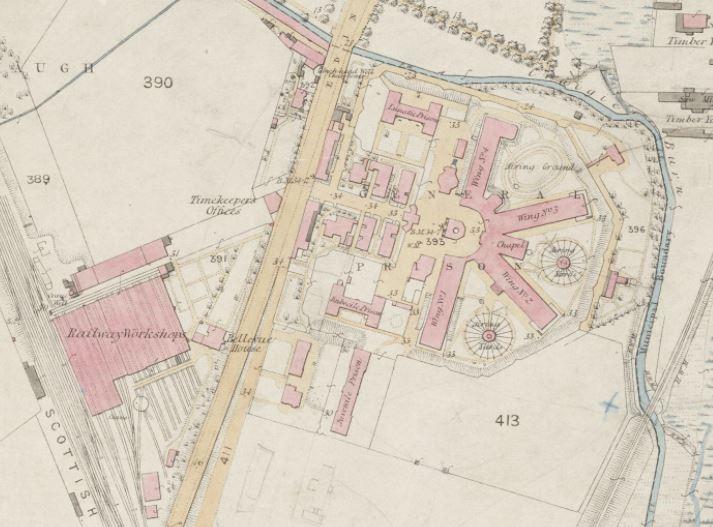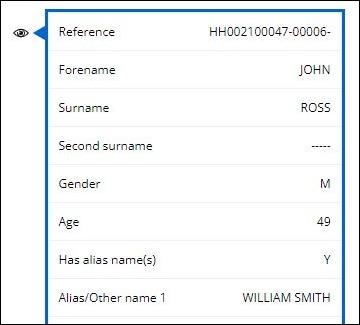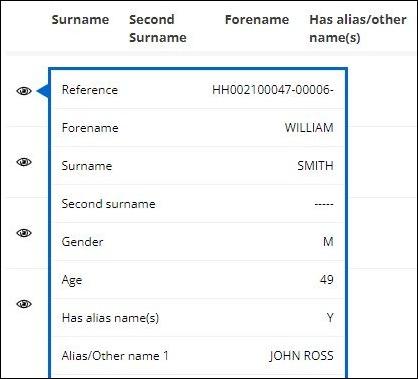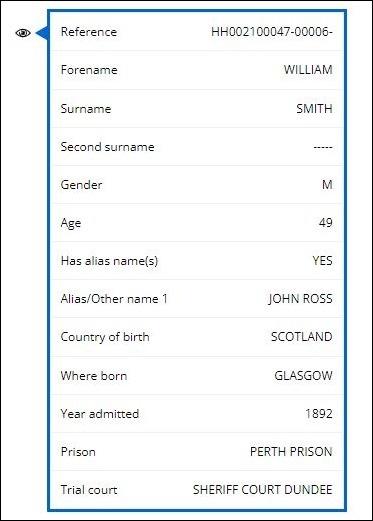Prison registers
Introduction
Scottish prisons and related legislation
What prison registers are available on ScotlandsPeople?
How to search prison registers
Understanding the content of prison registers
Related records
Related records not held by NRS
Further reading
Introduction
National Records of Scotland (NRS) holds prison records from the Scottish Prison Service (SPS) and its predecessor bodies (in particular the Scottish Home and Health Department Prisons Division) which had responsibility for the construction and running of Scotland’s prisons. Included in this collection are registers of prisoners (NRS, HH21), images of which are made available online for the first time.
Prison registers were maintained by each Scottish prison and record details of prisoners who were in custody, both tried and untried. They recorded daily admissions to prisons and are a valuable source of information for both family and social historians.
For each prisoner the registers generally include name, date of admission to the prison, particulars of the trial or offence and sentence, if convicted, and the date liberated or removed from the prison. They can also contain significant personal details such as age, place of birth, nationality, occupation, height, general health and religious persuasion.
The admission registers of Perth Prison, Largs Jail and Edinburgh's Bridewell and Calton Prisons are accessible on ScotlandsPeople (see What prison registers are available on ScotlandsPeople).

Detail from plan of Perth Prison, Perthshire: Ordnance Survey 1/2500 plan (Perthshire, XCVIII.9)
Crown copyright, National Records of Scotland, RHP9269/1
Scottish prisons and related legislation
Before the Gaol Act 1823, the condition of Scotland’s prisons was variable, but most were poor. Their management fell to burgh councils who were underfunded and lacked both the means and the willingness to improve facilities and accommodation for prisoners.
This Gaol Act, instigated by Robert Peel as Home Secretary, marked the start of government efforts to improve standards in prisons across the United Kingdom. It saw the removal of the use of manacles and irons from prisoners, payment of salaries for prison staff, regular visits by religious leaders, and permitted supervision of female prisoners by female wardens.
Further improvement measures were put in place with the introduction of the Prisons Act, 1835. This saw the appointment of five salaried prison inspectors who enforced the rebuilding of many prison buildings to implement a new and ‘separate system’ of imprisonment.
The principles of the separate system outlined in ‘An Act to Improve Prisons and Prison Discipline’ of 1839, proposed a General Prison for Scotland to facilitate complete separation of prisoners serving a sentence longer than nine months.
Perth Depot, a former military fort, was selected to be Scotland’s first General Prison as outlined under the 1839 Act, which vested general superintendence of all Scottish prisons in the General Board of Directors of Prisons in Scotland. County Boards were set up which took over management of all local prisons except the General Prison in Perth, which was administered directly by the General Board and was regarded as a government institution for the detention of criminals undergoing long sentences.
The Prisons (Scotland) Act 1860 saw many smaller prisons in Scotland close. Perth Prison became the model for the new wave of prison reform and helped enforce the principle of using incarceration in prisons as a deterrent to criminal behaviour, as outlined in the Prisons (Scotland) Act 1877. This Act saw complete control over Scottish prisons pass to The Home Office in London.
Our feature on the history of Perth Prison provides more historical background on Scotland’s first general prison.
What prison registers are available on ScotlandsPeople?
Select prison registers with dates of admission up to and including 1921 are available to search and view on ScotlandsPeople.
At present, the following registers are available:
- Edinburgh Bridewell, 1798-1840
- Edinburgh (Calton) Prison, 1841-1851
- Largs Prison, 1843-1853
- Perth convict journals (male), 1867 to 1879
- Perth Prison registers (male), 1888 to 1897, 1902 to 1909, 1913 to 1921
- Perth Prison registers (female), 1901 to 1916
Those Perth Prison registers dated between 1867 and 1879 (NRS, HH21/47/1-4) are described as ‘convict journals’. These four registers record the details of convicts who were sentenced to penal servitude in convict prisons located in the south of England. The Penal Servitude Act 1857 abolished the sentence of transportation in all cases and provided that a person who would otherwise have been liable to transportation would be liable to penal servitude instead. As such, these 1867 to 1879 registers do not record all admissions to Perth Prison; they merely record those convicts sentenced to long periods of penal servitude. These registers contain similar prisoner information to the regular prison registers which survive (with gaps) from 1888 (males) and 1901 (females) and which record all admissions to the prison.
Please note that some of the prison entries expand over multiple pages. To view these entries ScotlandsPeople customers will only be charged once to view the entirety of the entry relating to that prisoner. In these cases, above the image there will be an indication of the start and the end page for the entry and the next page button will say 'Next (paid)'.
Accessing other prison registers held by NRS
The NRS guide to Scottish crime and criminals lists all prison registers held by NRS. Note that the dates given are covering dates; there may be some gaps in the records. Few of these registers are indexed. Those records not available online on ScotlandsPeople will need to be viewed, by prior appointment, in the NRS Historical Search Room at General Register House, Edinburgh.
Information in later prison registers will not be available for public consultation until 84 years have passed since the date of admission to the prison. These records are exempt under Section 38(1)(b) of the Freedom of Information (Scotland) Act 2002: Personal Information.
How to search prison registers
The prison registers index currently comprises 130,224 index entries and 5,563 images of Perth Prison, Edinburgh Bridwell, Edinburgh (Calton) Prison, and Largs Prison admissions dating from 1798 to 1921 (with gaps).
You can search prison registers using some or all of the following index fields:
• Surname
• Forename
• Sex (Male, Female or Both)
• Age (an age range can be used, for example 20 to 30)
• Year admitted (a year range can be used, for example 1880 to 1890)
• Prison (a drop-down list of all prisons currently included in the index)
• Country of birth (a drop-down list of All, Scotland, England, Wales, Ireland, Outside UK/Ireland or Not Recorded)
• Trial court (the court from where the prisoner was committed; a free-text field, ideally not to be used when searching for a named prisoner)
The search form includes search tips for each field with links to more detailed research guides where appropriate.
Selecting a prison from the drop-down list and conducting a search with no other index fields entered will return all entries for that particular prison. The number of entries returned will not provide an accurate figure for the number of prisoners admitted to a particular prison. Many prisoners may have one or more ‘alias/other’ names (described below) given in the registers and each ‘alias/other’ name has been included as a separate searchable entry in the index, thus recording some individuals more than once in the index.
Place names are indexed as they are recorded in the registers. As such, the form and spelling of place names are not necessarily in modern form and might include errors made by the prison staff.
Selecting a country of birth from the drop-down list and conducting a search with no other index fields entered will return all entries for that particular country of origin. If the prisoner was born outside of the UK or Ireland, these entries are indexed separately under the 'Outside UK/Ireland' option on the drop-down list. Occasionally a prisoner did not provide a place of birth, or prison staff missed off this information. Selecting 'Not Recorded' will locate these entries. Where no data was recorded or the place of birth was stated as unknown, the entry will show a series of dashes, i.e., ------. Using the sort function on the search results page allows these numerous ‘other’ countries to be sorted alphabetically.
The ‘free text’ search for the name of the committing ‘trial court’ locates records of prisoners who were committed from a particular city or town. This should be used sparingly, and should generally not be used when searching for a named prisoner. For example, entering ‘Perth’ as a search term, with no other search terms entered, will return all results for individuals who were committed at trial courts in Perth, for example Perth Sheriff Court or the Justices of the Peace court at Perth.
Understanding the content of prison registers
Though the extent of details provided can vary between prisons, generally the registers contain the following details relating to prisoners in custody: name, date of admission, committing magistrate and court, age, height, where born, nationality, occupation, religion, health, offence, particulars of trial, sentence if convicted, and date liberated or removed to another prison or institution.

Example from Perth Prison admissions register, 1913.
Crown copyright, National Records of Scotland, HH21/47/14 page 60
On the main search results page, clicking on the header of each column of data will sort the data in either alphabetical or numeric order, whichever is relevant. Clicking once will order it as A-Z; clicking twice will order it as Z-A. You might wish to use a place of birth to identify a particular prisoner of interest, so sorting alphabetically by ‘Where born’ will allow you to cross-reference the name, age and place of birth.
Two of the main search results require further explanation.
Second surname



Examples from Perth Prison registers
Crown copyright, National Records of Scotland, HH21/47/8 (top image) and HH21/47/6 (middle and bottom image)
This column relates to a second surname given for an individual in the prison register. This is distinct from an ‘alias/other’ name, whereby a prisoner had an alternative forename, or more than two surnames given in the register (as described below). Although many males have a second surname given in the registers, it is most commonly found with female prisoners, who may have both their maiden surname and married surname included in the register, in the form of, for example, ‘Agnes Marshall or Brown’. ‘Marshall’ would be included in the ‘Surname’ column, whilst ‘Brown’ would be included in the ‘Second surname’ column.

Generally, the ‘Surname’ column contains the maiden surname, and the ‘Second surname’ column the married surname. This is not always consistent, given how surnames were recorded in the original registers, and often the surnames given would have been assumed names.
A search for the surname ‘Marshall’, for example, will return results for Marshall in both the ‘Surname’ and ‘Second surname’ columns.
Has alias/other name(s)?
This column alerts the user that an individual has one or more ‘alias/other’ names listed in the register, by displaying the letter ‘Y’ (yes). Any corresponding alternative name(s) will be included in the ‘More details’ feature, denoted by the eyeball symbol. This is a regular occurrence in prison registers.
For the purposes of indexing the prison registers, an ‘alias/other’ name is defined as where an individual has more than one forename given in the register, for example ‘John Ross alias William Smith’, or more than two surnames, for example ‘Elizabeth O’Neil or McGregor or Mitchell’, as in the below example from HH21/47/8.

In the below example, a search for John Ross has located the following result, indicating that he has an ‘alias/other’ name given in the register.

Clicking on the ‘More details’ feature for John Ross provides the corresponding ‘alias’ name of William Smith, allowing you to cross-reference.

The register entry from HH21/47/6 looks like this, showing the ‘alias’ name.

In the index, there is also a corresponding entry for William Smith, which includes John Ross as the ‘alias/other’ name under ‘More details’. Either name is searchable and can be cross-referenced.


General notes on searching surnames in prison registers
All ‘Mc’ surnames have been expanded to ‘Mac’ to account for inconsistencies in the rendering of Mc, Mac and M' names by the recording clerk.
No punctuation is included in the indexes. The surname O’Neill, for example, will be indexed as ONEILL.
When searching the indexes, please also be aware that the spelling of a surname may not be as you expect owing to:
• Mis-spelling, phonetic spelling or other misinterpretation by the prison staff.
• Surname variants.
• Alteration or Anglicisation of a surname upon arrival in Scotland.
• Alteration or Anglicisation of Gaelic surnames of prisoners originating from the Highlands and Islands of Scotland, for example, MacIan to Johnston.
‘More details’
A new feature on ScotlandsPeople, utilised for the first time with prison registers, is the ‘More details’ function. To the left of each individual search result is an eyeball symbol. Clicking on this enables you to view additional index details for each prisoner, which cannot fit onto the main search results screen. The example below of the 'More details' function shows you what information is included.

Related records
The prison register will often state at which court the individual was tried and the date of the trial. You can use this information to find out more about the court cases that led to the conviction and imprisonment of prisoners recorded in prison registers.
Note that many criminal court records, particularly for relatively minor offences, have not been preserved. Depending on the court, some records are held at the National Records of Scotland (NRS), whilst others are held at local authority archives. A majority of these records are not indexed and those records which have survived are not available online.
A guide to records relating to Scottish crime and criminals is available on the NRS website. This includes guidance on researching records of the High Court of Justiciary (Scotland’s supreme criminal court), sheriff courts (local courts) and Justices of the Peace courts. These records, if they have survived, can be viewed in the NRS Historical Search Room.
High Court of Justiciary records
More serious criminal cases were heard at the High Court of Justiciary (NRS, JC), which included murder, rape, treason, counterfeiting and crimes of a sexual nature. The court sat in Edinburgh and travelled to other principal towns on circuit. Individual High Court cases, the records of which are at least 100 years old, can be searched using the name of the prisoner on the NRS online catalogue. Case papers and minute book entries will be of particular interest. If you wish to locate these records, you should search the catalogue using the reference JC, then provide a name in the ‘Search for’ field. Any entries returned with a reference beginning JC26 will be case papers.
Sheriff court records
The local sheriff courts (NRS, SC) deal with both civil and criminal cases. Sheriff court criminal trials are for lesser crimes, commonly theft and assault. There are different types of sheriff court trials. More serious cases are heard before a sheriff and jury, and are known as ‘solemn’ trials; depending on the court, records can be called a number of different things, including:
• Criminal court books
• Criminal records
• Criminal registers
• Jury trials
• Libels
• Indictments
Less serious cases are heard before the sheriff alone, and are called ‘summary’ trials. Records of these are normally catalogued as ‘criminal and quasi-criminal roll books’ or ‘records of summary trials’. For most of the 20th century, there were also separate trials for juveniles. Usually, surviving records of summary trials will be limited to a one-line register entry under the hearing date.
In order to view sheriff court trial records, you firstly need to know the NRS catalogue reference. Please note that the sheriff court criminal trial records have not been catalogued by name and so researchers will need to identify the volume in which the trial is recorded, and will need to search that volume in person to locate an individual of interest.
Justices of the Peace court records
Justices of the Peace (NRS, JP) had civil court powers and administrative functions as well as criminal authority. Criminal cases before the JPs include minor assault, breach of peace, irregular marriages, prostitution, riot, theft and the violation of laws relating to excise cases, liquor licensing, poaching, roads and (since 1932) juvenile court cases. As JPs were usually more concerned to reduce local expenditure than to incur it, they tended to fine rather than to imprison and the records of their criminal hearings are usually brief.
Records of the Justices of the Peace courts are not catalogued by name and researchers will need to search the reference JP on the NRS catalogue to identify the volume in which the trial is recorded, and then search that volume in person to locate an individual of interest.
Many surviving records of the Justices of the Peace courts are held by local authority archives. You should consult the NRS catalogue for further details.
Restricted access to court records held by NRS
Information contained in most criminal trial records of the High Court of Justiciary and the sheriff courts is exempt under Section 38 of the Freedom of Information (Scotland) Act 2002: Personal Information. As such, these records will not be available for public consultation for 100 years from the date of the record.
Related records not held by NRS
The following court records are not held by NRS. You should contact the relevant local authority archive to enquire as to the survival and availability of these records. Contact details for United Kingdom local authority archives can be located on The National Archives website.
Police and magistrates’ court records
Prison registers often record that local police or magistrates’ courts dealt with the criminal charges and sentencing of many of the prisoners listed. Police courts largely dealt with minor misdemeanours including drunkenness, minor assault and breach of the peace. These records, if they have survived, should be held in local authority archives and do not form part of NRS collections.
English court records
Often, prison registers will state that a prisoner was tried at a court in England. This will usually be one of three types of court: assizes (courts held in the main county towns and presided over by visiting judges from the higher courts), quarter sessions (local county courts held four times per year), and petty sessions (also known as magistrates’ courts) who dealt with minor offences. Records of trials heard at these courts will be held by local authority archives in England.
Further reading
You may find the handwriting in the prison records difficult to read. Look at the guides on reading older handwriting, unfamiliar words and phrases, and search the glossary for assistance with abbreviations, legal terminology, occupations and other unfamiliar words.
A guide to records of crime and criminals, including Scottish prisons, held by NRS.
Joy Cameron, Prisons and Punishment in Scotland: From the Middle Ages to the Present, Edinburgh, 1983.
David F. Smith, 'Scottish Prisons under the General Board of Directors, 1840-1861', Albion: A Quarterly Journal Concerned with British Studies, Vol. 15, No. 4 (Winter, 1983), pp. 287-312.
